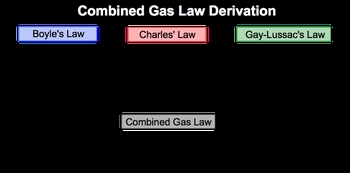Here in this example question, it says, a sample of gas initially has a volume of 900 milliliters at 520 kelvin and 1.85 atmospheres. What is the pressure of the gas if the volume decreases to 330 milliliters while the temperature increases to 770 kelvin? Alright. So in this question, they're giving me a volume. We're going to say it's V1, because later on they give me a second new volume, V2. They give me a temperature T1, and then later give me a second temperature T2. They give me this pressure in atmospheres, so this is P1 because later they ask me what the new pressure is. So they're asking us to find P2.
Now we have our ideal gas law PV = nRT. If you have watched my videos on ideal gas law derivations, you know that we can manipulate the ideal gas law in order to get our combined gas law. Now if you haven't watched those videos, I highly suggest you go back and take a look. So look under ideal gas derivation videos. Now here we're talking about 2 pressures, 2 volumes, and 2 temperatures. Moles aren't being discussed because they're being held constant. R is a constant. We divide out the T so that everything is on the left side. And we see that since we're dealing with 2 different values for these variables, it becomes P1V1T1 = P2V2T2. So here we just showed how we derived the combined gas law.
Alright. So now we're going to plug in the values that we have. Our pressure is 1.85 atmospheres initially. Our volume when we change milliliters to liters gives us 0.900 liters. Remember, temperature must always be in kelvins when doing calculations. It's already in kelvins, so we don't have to worry about that. We don't know what P2 is, V2 is 0.330 liters, and then temperature T2 is 770 Kelvin. We're just looking to isolate P2, so you can cross-multiply these, and then you can cross-multiply these, so that you can isolate P2. So if I come over here, I'm going to see that, P2 = 1.85 atmospheres × 0.900 liters × 770 kelvins0.330 liters × 520 kelvins.
So we divide out the volume and the temperature that we have here on both sides. So dividing both sides by that, we have isolated at the end our P2. So liters and kelvins cancel out, and we'll see here that P2 equals 7.47 atmospheres. So we can see that by changing our volume and changing our temperature, it has caused this change in our pressure too, which comes out again to 7.47 atmospheres.


